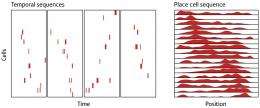Ensembles of neurons in the brain's hippocampus inform about future as well as past experiences

When a mammal explores an unfamiliar environment, ensembles of ‘place’ cells in the hippocampus fire individually, recording specific locations in a cognitive map that aid future spatial navigation of the area. Once the relationship between place cell activity and location has been established, the activity of the cells can be used to predict the animal’s location within its environment. Activity patterns in the ensembles are later ‘replayed’ during rest and sleep, and neuroscientists believe this is important for consolidating the spatial memories of the new environment.
Neuroscientists also contend that the sequence of place cell firing corresponding to the new environment is established during the first exploration of that environment. Now George Dragoi and Susumu Tonegawa from the RIKEN-MIT Center for Neural Circuit Genetics at the Massachusetts Institute of Technology in Cambridge, Massachusetts, report that the activity of place cell circuits is also preconfigured to encode novel environments.
Dragoi and Tonegawa recorded the activity patterns of place cells in the CA1 region of the hippocampus while mice navigated a familiar environment. They also recorded from the same cells afterwards, while the mice rested or slept. As expected, some of the place cell activity patterns they observed corresponded to the familiar environment that the animals had explored, but they also recorded new patterns from place cells that were previously silent.
The researchers found that the novel activity patterns corresponded strongly to the sequences of place cell firing that were recorded when the mice subsequently explored an unfamiliar part of the environment. This suggests that the activity patterns represent ‘preplay’ of the unexplored locations rather than replay of the familiar part of the environment. Thus, the activity of hippocampal place cells appears not only to consolidate spatial memories of newly experienced environments, but also to predict how novel, unexplored environments can be encoded when they are navigated in the future. The researchers also suggest that hippocampal preplay may accelerate spatial memory formation once the novel environment is eventually explored.
“Encoding of new information makes use of the pre-existing organization of the hippocampal network, and will stabilize faster compared to a case when the neuronal network has to re-organize to a new state that does not resemble the pre-existing one,” says Dragoi. “In an immediate follow-up to this study, we will address the role of the intact hippocampal circuitry in the mechanisms and dynamics of the preplay phenomenon,” he adds.
More information: Dragoi, G. & Tonegawa, S. Preplay of future place cell sequences by hippocampal cellular assemblies. Nature 469, 397–401 (2011). www.nature.com/nature/journal/ … abs/nature09633.html














